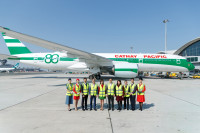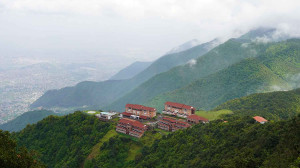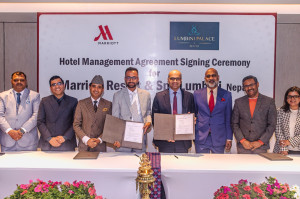Money
Nearly 900 Nepalis, foreign trekkers, airlifted
Choppers have started airlifting climbers and trekkers stranded in Gorkha after Tsum Nubri residents called off their protest.
Post Report
Nearly 900 people, including foreign trekkers, have been rescued by helicopters from different flood-hit areas in the last two days after severe flooding and landslides disrupted vehicular movement across Nepal.
Rishiram Tiwari, spokesperson of the Home Ministry, said Nepal Army choppers rescued 683 people—425 people on Sunday and 258 on Monday. “The rescue is ongoing,” he said.
“Apart from disaster response conducted by the Nepal Army, private choppers have also been rescuing stranded foreigners, particularly in the mountain region.”
The exact number of rescues conducted by private choppers is unknown, but operators said roughly 200 foreign trekkers and a few Nepalis have been evacuated in the last two days.
Most highways across Nepal have been blocked by landslides and fallen trees, leaving thousands of travellers stranded. As a precaution, the government has banned nighttime bus service on some highways.
According to the Home Ministry statement, the death toll from the landslides and flooding has risen to 209. Twenty-nine others are missing.
The Nepal Army conducted emergency rescue operations in Kavrepalanchok and Sindhuli after the BP Highway was cut off, leaving hundreds of people stranded.
The Airlines Operators Association of Nepal, the apex body of private operators, said they have been conducting rescues from the Everest region, Simikot, Manaslu, Langtang, Manthali, and other areas.
Murali Dhar Joshi, the association's spokesperson, said an estimated 150 trekkers were stranded in Lukla, the gateway to the Everest region, after flights were affected since Thursday after heavy rains.
“Flights have now resumed in Lukla, and we are evacuating trekkers,” he said. “We have also rescued trekkers from Khare and Lobuchee in the Everest region, who were stranded by the snowfall,” said Joshi of Simrik Air.
He said that since it is trekking season, the movement of trekkers from Kathmandu to Lukla may rise in the coming days.
Anil Manandhar, Corporate Manager at Shree Airlines, said they have been conducting rescues of both foreigners and Nepali citizens from different mountain areas, including Nepalthok in Kavrepalanchok.
“On Monday, we rescued 25 people from different places.”
According to him, nine Nepalis were rescued from Nepalthok, four (three foreigners and a Nepali) from Manang, three foreign trekkers from Langtang, and five foreign trekkers from Namchhe in the Everest region on Monday.
Ramechhap Airport at Manthali, used for flights ferrying trekkers to Lukla during the peak season, has also been flooded. “The airport has since reopened, and foreigners were flown to Kathmandu,” said Joshi.
Meanwhile, choppers have started airlifting hundreds of foreign mountaineers and trekkers stranded in Samagoan of Gorkha, to Kathmandu after protesting locals of Tsum Nubri Rural Municipality, in the Nepal-China border, were invited by the Home Minister to resolve the issue through talks.
The locals of northern Gorkha have been protesting against the government for the last two weeks, demanding that Tsum Nubri rural municipality be removed from the list of restricted areas and chopper rescue operations be made easier.
Nima Lama, chairman of Tsum Nubri Rural Municipality, said they are holding a discussion with the Home Ministry officials on Tuesday in Kathmandu.
“The government has established a security camp at the border, and hence, there is no need to keep Tsum Nubri rural municipality in the restricted list,” he said. “Why do foreigners get a flying permit instantly, but locals have to wait for weeks for a rescue or medical evacuation flight? People are dying here due to slow emergency response.”
Locals have also called for emergency rescue operations based on police recommendations, bypassing the existing lengthy approval process.
Nearly 600 foreigners were stranded after the locals barred choppers from landing in the area.
According to Lama, 40 evacuation flights were conducted on Monday after the protest was suspended on Sunday.
Upper Mustang, upper Dolpo, Manaslu, lower Dolpo, upper Gorkha, Rasuwa, Manang, Humla, Mugu, Makalu, Kanchenjunga, Gunsha in Taplejung, and a few areas in Dolakha are among the restricted areas in Nepal where even helicopters cannot enter without a special permit.
The process of obtaining a permit is so long that patients requiring urgent medical care risk dying before help arrives. The restricted areas lie along the northern border with China. In these places, lengthy official procedures must be completed to fly sick or injured persons to hospitals.
According to a representative of a helicopter company, to get a permit, they have to make the rounds of the Home and Tourism ministries and the Civil Aviation Authority of Nepal. There are many cases of sick or injured people dying by the time the permit is finally granted, the representative said.
According to helicopter operators, there are typically six steps involved in obtaining a permit for medical evacuation flight. First, the family chartering the flight has to submit a request in writing to the chief district officer of the district concerned, and also provide a copy of the application to the helicopter company.
Second, the helicopter company must write separately to the chief district officer. Third, after the application is verified, the chief district officer writes to the Home Ministry recommending that a permit be issued.
Fourth, the Home Ministry issues a permit based on the identity of the sick or injured person.
Fifth, the Home Ministry writes to the Tourism Ministry stating that security issues have been cleared and the helicopter may be granted a permit. Finally, the Tourism Ministry writes to the Civil Aviation Authority of Nepal to issue a permit.
On different occasions, the former parliamentary International Relations Committee directed the government to make arrangements for issuing helicopter rescue permits in restricted areas through local administrations. However, the directive has not been heeded.
The House panel issued the directive following complaints about an increase in the number of deaths caused by delays in medical evacuation flights due to complex paperwork.




 13.05°C Kathmandu
13.05°C Kathmandu














